20 mm/65 Breda anti-aircraft gun

Contents
Description
Write an introduction to the article in 2-3 small paragraphs. Briefly tell us about the history of the development and combat using the weaponry and also about its features. Compile a list of air, ground, or naval vehicles that feature this weapon system in the game.
Vehicles equipped with this weapon
| Vehicles equipped with this weapon | |
|---|---|
| Motor gun boats | MV-611 |
| Motor torpedo boats | MAS 555 · MAS 561 · MAS 569 · MS-15 · MS-53 · VAS 201 · GIS 811 |
| Sub-chasers | RN Gabbiano |
| Destroyers | RN Aviere · RN Corazziere · RN Geniere |
| Light Cruisers | RN Duca degli Abruzzi |
| Battleships | RN Conte di Cavour · RN Duilio |
General info
Tell us about the tactical and technical characteristics of the cannon or machine gun.
Available ammunition
- Universal: API-T · HEFI-T*
- HE belt: HEFI-T* · HEFI-T* · HEFI-T* · API-T
- AP belt: API-T · API-T · API-T · HEFI-T*
| Penetration statistics | |||||||
|---|---|---|---|---|---|---|---|
| Ammunition | Penetration @ 0° Angle of Attack (mm) | ||||||
| 10 m | 100 m | 500 m | 1,000 m | 1,500 m | 2,000 m | ||
| HEFI-T* | 4 | 4 | 4 | 4 | 4 | 4 | |
| API-T | 38 | 36 | 27 | 19 | 14 | 10 | |
| Shell details | ||||||||||||
|---|---|---|---|---|---|---|---|---|---|---|---|---|
| Ammunition | Velocity (m/s) |
Projectile mass (kg) |
Fuse delay (s) |
Fuse sensitivity (mm) |
Explosive mass (TNT equivalent) (g) |
Ricochet | ||||||
| 0% | 50% | 100% | ||||||||||
| HEFI-T* | 830 | 0.14 | 0 | 0.1 | 3 | 79° | 80° | 81° | ||||
| API-T | 832 | 0.14 | 0.001 | 1 | 1.7 | 47° | 60° | 65° | ||||
Comparison with analogues
Give a comparative description of cannons/machine guns that have firepower equal to this weapon.
Usage in battles
Describe the cannon/machine gun in the game - its distinctive features, tactics of usage against notable opponents. Please don't write a "guide" - do not impose a single point of view, but give the reader food for thought.
Pros and cons
Summarise and briefly evaluate the weaponry in terms of its characteristics and combat effectiveness. Mark pros and cons as a list.
Pros:
- Excellent vertical guidance
- Good damage output
- Very fast reload time compared to the nearest peers
Cons:
- Small magazine size
History
A scaled-up version of the Breda Model 31 machine gun, the 20-millimetre/65-calibre Breda is a naval anti-aircraft cannon designed for dual-purpose use. A variant of the Regio Esercito (Royal Italian Army) Breda Mod.35, the Breda is the same gun mounted on an anti-aircraft platform for the Regia Marina (Royal Italian Navy). Like its army counterpart, this gun was adopted in 1935 but was initially issued on a dual mount that used the same base as the large 37 mm/54 Breda Mod.32. However, it means this twin mount had the same faults as the larger cannons including high vibrations and a need for a strong support structure. It also suffered from only carrying 12 rounds meaning frequent reloads and a low rate of fire. The later 1939 and 1940 single mounts fixed these problems and added better sights. The 1940 mount was particularly used by the MAS torpedo boats. While seen by the Regia Marina as an effective weapon, it was overall inferior to the 20 mm/70 Oerlikon guns they adopted in limited numbers in 1941.
Alongside Italy, the Breda was used in other countries as well. The Swedish Navy purchased two Spica-class torpedo boats renamed the Romulus class which came with these guns designated as the Akan m/38. The Finnish Navy bought four Jymy-class motor torpedo boats. A significant number of Bredas were captured by the British in North Africa during Operation Compass and alongside use by the British Army was used by both the Royal Navy and Royal Australian Navy ships including HMAS Perth, HMAS Vendetta, and HMS Ladybird.
Media
Excellent additions to the article would be video guides, screenshots from the game, and photos.
See also
- Breda Mod.35 (20 mm) - land variant.
External links
Paste links to sources and external resources, such as:
- topic on the official game forum;
- other literature.



